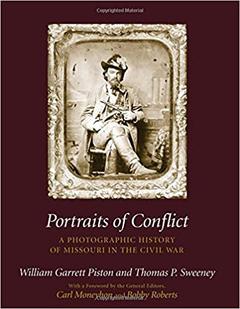April 2023 Program Summary

At our dinner meeting on April 19th, Dr. William Garrett Piston gave an interesting presentation about the book that he co-authored with Thomas P. Sweeney titled: Portraits of Conflict, A Photographic History of Missouri in the Civil War. The meeting was very well attended. Attendance at the dinner meeting was 75!
The key points made during Dr. Piston’s presentation are as follows:
- Dr. Piston’s book is part of a series of books meant to include portraits and an overview of each Confederate State. The first book in the series was Portraits of Conflict — Arkansas.
- This was the only book that Dr. Piston worked on with Dr. Thomas P. Sweeney. Dr. Sweeney had the best collection of Civil War images related to the trans-Mississippi region.
- Dr. Piston’s presentation focused on the following topics:
- Photography in Missouri during the Civil War.
- Securing Missouri for the Union.
- Guerrilla war.
- Missourians and the war on the rivers.
- Civil War medicine in Missouri.
- The Civil War was the first generation of Americans who would be sitting in front of a camera and then going off to face death. It might be the last image his family would ever see of him.
- Photography came to Missouri in the 1840’s. St. Louis had a lot of photographers. Photography was a big city phenomena. There were also photographers in Kansas City, Jefferson City, Sedalia, Springfield, Rolla, St. Charles, and Hannibal. Photographers could copy another photographer’s photos by taking photographs.
- During the 1850’s and 1860’s there were a lot of photographers in Missouri. Photographers needed a shop or studio, which could be in their home. Getting the light correct was tricky. Skylights provided additonal light, which made a huge difference.
- Photographs became portable. Rudolph H. Goebel had a photoperipatetigraph wagon that he traveled around with to take photographs. It was another way to make money. Photographers could also take photographs of dead soldiers.
- Soldiers could draw inspiration from the home folks by having photos of their wives, sweethearts, and families.
- The photograph on the cover of his book is of George Maddox, a guerrilla fighter who served under Quantrill. In 1866, Maddox was the only guerrilla to stand trial for the Lawrence Raid. He was tried and acquitted.
- Dr. Piston said the term “guerrilla” was a matter of definition. It could be used against you. The Union government labeled all soldiers recuited in Missouri as guerrillas.
- Dr. Piston said the term “guerrilla” was a matter of definition. It could be used against you. The Union government labeled all soldiers recuited in Missouri as guerrillas.
- The Missouri State Militia (MSM) were armed, anti-guerrilla fighters. The MSM got started in 1862 in response to the Confederates recruiting guerrilla fighters.
- James B. Eads (1820-1887) was a world-renowned civil engineer. He lobbied the Lincoln administration and convinced President Lincoln to build ironclad gunboats on the western rivers. This greatly helped Grant’s campaign against Confederate forts Henry and Donelson in 1862. The Confederates could never match the Union gunboats on the rivers.
- Commander John Roberts and Eads drew up a set of requirments for a fleet of armored gunboats that would operate on the Mississippi River. This resulted in city-class ironclads. Bands were painted on the smokestacks to identify each vessel.
- Eads wanted armored gunboats and the U.S. Navy built them in a hurry. However, lightly armored gunboats took a pounding from Confederate shore batteries. The USS Mound City was converted from an existing vessel into a heavily armored gunboat. The Eads shipyard built a total of seven city-class ironclads within five months. The cooperation between the U.S. Army and Navy was very high.
- Dr. Piston said there were about 180,000 African Americans that served in the U.S. Army. Approximately 2,000 runaway slaves served in the Western navies and made great contributions.
- Civil War medicine: Doctors on both sides worked on wounded soldiers. This is one of the best examples of compassion during the Civil War. The overwhelming number of physicians on both sides had never treated gunshot wounds. They had to learn on the fly. It is amazing how many civilians became great doctors.
- The wounded were sent to hospitals. The wounded soldiers in Missouri got the best medical care available at that time. The convention for both sides was that doctors were not captured and were allowed to treat the wounded.
- Dr. Piston showed numerous photos of Missouri soldiers, guerrilla fighters, doctors, buildings, and gunboats from the Civil War. He also told stories that went along with the photos.

|
| |